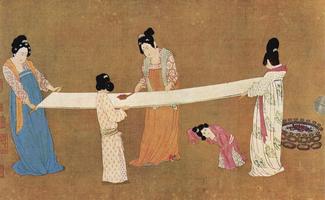For Their Dyes Only: the Secret of Silk
By: Rachel T, rachel.t@annarbortees.com
almost 7 years
In our previous post, The Hairy Origins of Screen Printing, we discussed the Chinese invention of screen printing using human hair. This post will cover how the next big advance in screen printing began with the discovery of silk in China. Silk comes from the cocoon of the mulberry silk moth (Bombyx mori, for those who care or pretend to read latin). The caterpillar spins its cocoon from a single thread of hardened spit measuring close to 1000 yards. China started weaving silk around 3,000 BCE, even further back than the Pyramids of Giza.
Who exactly discovered silk?
According to an old Confucius legend, the Chinese Empress Leizu discovered silk when a cocoon fell into her tea and unraveled. The empress then had the clever idea to weave some of it in a loom. However silk got its start, China’s new fabric became a luxury produced only for the royal family and those they deemed worthy.
So, how did silk spread?
Eventually, the rules about who could wear silk became more relaxed. It soon became a huge source of revenue for traders and merchants who would pay for silk’s weight in gold. As a result, China maintained a monopoly on silk production and all things related. This meant the weaving process, the caterpillars, and the mulberry leaves they ate all became a carefully guarded secret. Unfortunately, loose lips, bribery, theft, and kidnappings of workers spread the secret. Soon, smugglers carried worms to countries like Korea, Japan, and India. These countries spun their own unique threads into the process.
What started as fashion for the wealthy elite soon spread all along the “silk road” and into Europe in the 1700’s. As silk became more widespread and less expensive, people found its uses in all manner of things. By 1870, France began using silk stretched over wood frames for printing textiles. These silk screens worked much better than the rough cotton and human hair screens of the past.
Is silk still used in screen printing?
The new silk meshes resulted in the term “silkscreening.” Printers still use this term today even though most mesh screens are now polyester, nylon or even metal. These materials are stronger, do not unravel in water, and aren’t dyed by the inks and pigments used. More great technological developments would unfold as the need for screen printing grew. Read on to our next post, Let Them Screen Prints!: Production for the Masses, to learn how the Industrial Revolution changed screen printing.
Interested in buying a shirt?
Request PricingReferences
- http://www.ooshirts.com/guides/History-of-Screen-Printing.html
- http://www.visual-arts-cork.com/prehistoric/hand-stencils-rock-art.htm
- http://www.brighthub.com/multimedia/publishing/articles/105324.aspx
- http://revolverwarholgallery.com/andy-warhol-screenprints-process-history/
- https://www.dfcscreenprinting.com/blog/the-history-of-silk-screen-printing.html
- http://www.visual-arts-cork.com/printmaking/screen-printing.htm
- https://en.wikipedia.org/wiki/Silk
- https://en.wikipedia.org/wiki/Screen_printing
- http://www.gwent.org/gem_screen_printing.html#history
- Book - Mental Floss History of the World
- https://en.wikipedia.org/wiki/Mimeograph
- http://homepage.usask.ca/~nis715/scrnprnt.html
Tags: #screen printing, #learn about printing, #history



